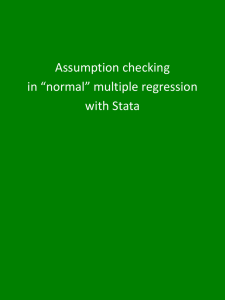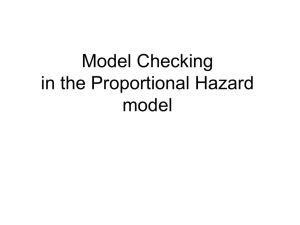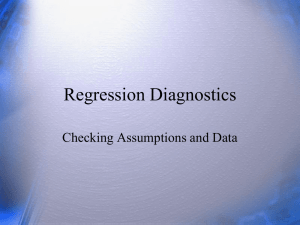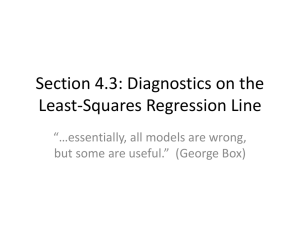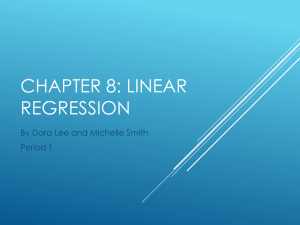Zuraniewski_Anomaly detection in VoIP and Ethernet
advertisement
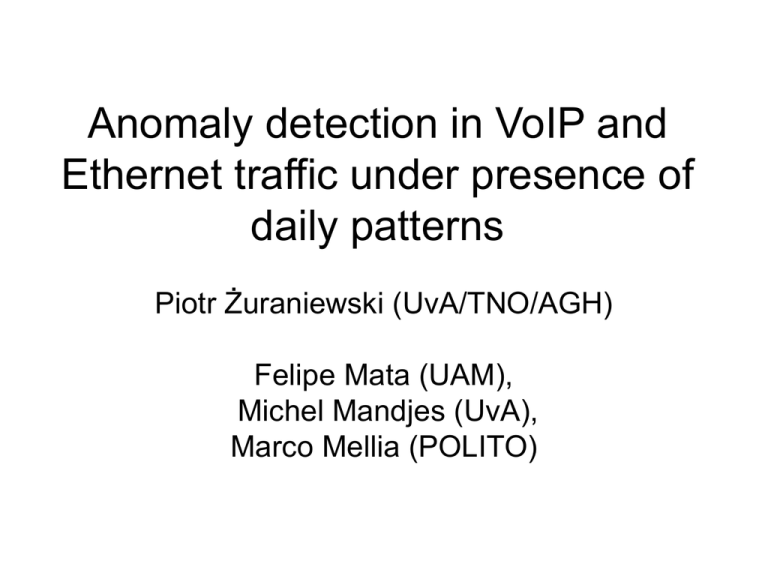
Anomaly detection in VoIP and
Ethernet traffic under presence of
daily patterns
Piotr Żuraniewski (UvA/TNO/AGH)
Felipe Mata (UAM),
Michel Mandjes (UvA),
Marco Mellia (POLITO)
Changepoint detection
• Changepoint detection: finding that
current statistical description of data
sample is no longer valid
• Problem can be formulated in
language of statistical hypothesis test
Benefits of changepoint detection
• Deviation from normal system state
can be detected (anomaly detection)
– attack on ICT infrastructure (excessive number of
TCP SYN packets)
– failure (excessive/too low traffic volume)
– Service Level Agreement not met (delay out of
acceptable range)
• Human experts empowered with
additional tool
Benefits of statistics-based
approach
• Manual and on-line analysis of large data
volumes may be infeasible
• Visual inspection may be insufficient due to
some hidden structures in data
• Objective and unbiased opinion of human not
always available
• Possibility to control false alarm ratio/detection
ratio
Problems
• Changepoint detection procedures often
assume independent observations
• Real life: dependency is present
– stochastic one (mind ‘fractal’ models)
– deterministic (e.g., diurnal trends)
• High dependency may ruin changepoint
detection test
Possible solution
• Estimate and remove trend from traffic
– for VoIP traffic: try to exploit possible local
Poissonian behavior
– exploit periodicity
• Only than apply changepoint detection
procedure(s) to residuals
– residuals should be (approx.) standard normal
– anomaly: change from N(0,1) to N(m,s)
Traffic, trend, residuals (no nights)
7
Contribution
• We have developed changepoint detection
test able to detect simultaneous change in
mean and variance for Gaussian input
• We have numerically assessed sensitivity
to deviation from independence
assumption
– our simple trend removal method may still
leave some dependency in residuals
Synthetic Gaussian trace
• Window of 50 observation presented to detector,
sequential manner, delta – relative position of changepoint
• True change from N(0,1) to N(3.07,1.082) from window
152 on (Erlang: it would give 0.1% blocking prob.)
• 500 experiments, good performance
1
0.8
0.8
0.6
0.6
true delta
Q 2.5% of detected deltas
Q 25% of detected deltas
Q 50% of detected deltas
Q 75% of detected deltas
Q 97.5% of detected deltas
detection ratio
1
0.4
0.4
0.2
0.2
0
0
100
200
300
window number
400
0
0
100
200
300
window number
400
Dependent input
• What if input to detection procedure is
correlated?
• Verification with genarated AR(1) traces
• Recall: {Xi} is AR(1) process if it follows
X i X i 1 i ; - mean; i - whitenoise
• AR(1) autocorrelation (linear dependency
measure) function is:
k k , k 0,1,
Correlated input – results
phi
0
5.7%
detection
ratio for
window
no. 152
76.6%
false
alarm
ratio
(regen.)
5.7%
0.2
10.1%
77.9%
5.3%
0.4
17.7%
80.8%
10.4%
0.6
27.2%
85.9%
17.9%
0.8
36.8%
90.3%
24.0%
1
0.8
detection ratio
mean
false
alarm
ratio
0.6
0.4
0.2
0
0
100
200
300
window number
• Correlation results in performance degradation
• Due to dependency, false alarm ratio (FA) ratio in window k
influences FA prob. in window k+1
• To assess this effect, FA is calculated for fully regenerated sample
400
Real data example
data, pattern, detected anomalies (week 5)
1
calls
500
0.5
calls
pattern
0
0
100
200
time
300
0
400
Ethernet traffic
• Poissonian assumption may be
problematic
• Mean and variance to be estimated
• Less regularity
• Periodic moving average and simple
moving average?
Ethernet traffic (NREN)
• Some traces show some regular patterns
7
Bps (10min. avg)
4
x 10
3
2
1
0
1.279
1.28
1.281 1.282 1.283 1.284 1.285
time (UNIX stamp) x 109
Trends
6
10
x 10
original trace
estimated pattern
estimated periodic pattern
estimated MA pattern
Bps (10min. avg)
8
6
4
2
5660
5680
5700
time
5720
5740
Trends
6
x 10
16original trace
Bps (10min. avg)
estimated pattern
14estimated periodic pattern
12estimated MA pattern
10
8
6
4
2
6680
6700
6720
time
6740
Residuals
7
1.5
x 10
residuals = trace - pattern
Bps (10min. avg)
1
0.5
0
-0.5
-1
0
2000
4000
6000
time
8000
10000
Busy hour
• The same model for day and night, working day and
weekend may not be optimal in all cases
• Now we focus on7 busy hour (8-15), no weekends
4
x 10
Bps (10min. avg)
original trace
busy hour 8-15, no weekends
3
2
1
0
1.279
1.28
1.281 1.282 1.283 1.284 1.285
9
time
x 10
Residuals
6
14
x 10
residuals
12
10
Bps (10min. avg)
8
6
4
2
0
-2
-4
800
1000
1200
1400
time
1600
1800
2000
Residuals – 1st part
6
14
QQ Plot of Sample Data versus Standard Normal
x 10
140
12
120
Quantiles of Input Sample
10
100
8
6
80
4
60
2
0
40
-2
20
-4
-6
-4
-3
-2
-1
0
1
Standard Normal Quantiles
2
3
4
0
-6
-4
-2
0
2
4
6
8
10
12
14
6
x 10
Residuals 2nd part
7
1.5
QQ Plot of Sample Data versus Standard Normal
x 10
45
40
Quantiles of Input Sample
1
35
30
0.5
25
20
0
15
10
-0.5
5
-1
-4
-3
-2
-1
0
1
Standard Normal Quantiles
2
3
4
0
-6
-4
-2
0
2
4
6
8
10
12
14
6
x 10
Summary
• We have extended anomaly-detection
method developed for stationary VoIP
traffic
• Diurnal trends taken into consideration
• Statistical framework as a basis but…
• …practitioner’s perspective –
simplifications – also considered
• Other type of traffic – more challenges




